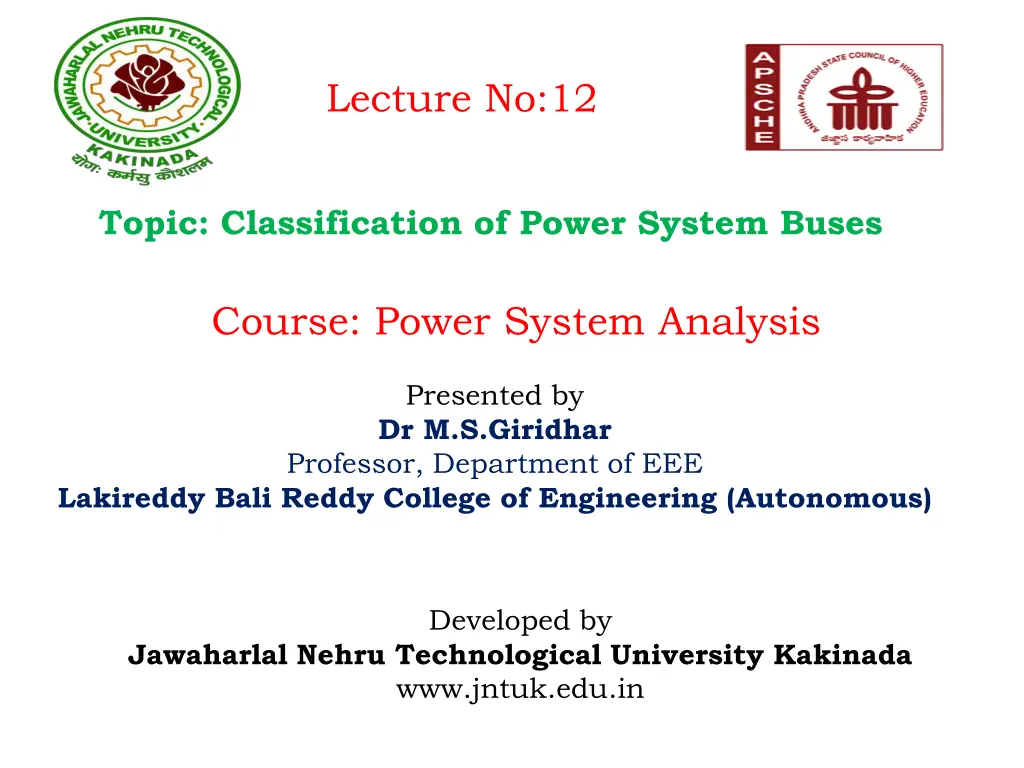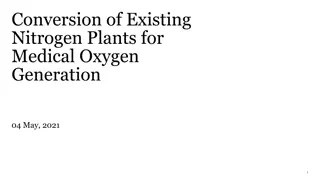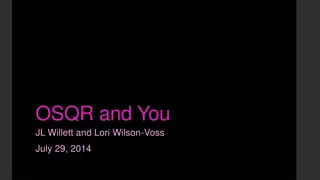
Understanding Power System Buses and Network Classification
Explore the classification of power system buses, equations, problem solving techniques, types of buses, and equations in a power system network. Learn about voltage-controlled buses, load buses, slack buses, and more in power system analysis.
Download Presentation

Please find below an Image/Link to download the presentation.
The content on the website is provided AS IS for your information and personal use only. It may not be sold, licensed, or shared on other websites without obtaining consent from the author. If you encounter any issues during the download, it is possible that the publisher has removed the file from their server.
You are allowed to download the files provided on this website for personal or commercial use, subject to the condition that they are used lawfully. All files are the property of their respective owners.
The content on the website is provided AS IS for your information and personal use only. It may not be sold, licensed, or shared on other websites without obtaining consent from the author.
E N D
Presentation Transcript
Lecture No:12 Topic: Classification of Power System Buses Course: Power System Analysis Presented by Dr M.S.Giridhar Professor, Department of EEE Lakireddy Bali Reddy College of Engineering (Autonomous) Developed by Jawaharlal Nehru Technological University Kakinada www.jntuk.edu.in
Power flow problem P2 ith BUS Pgi Pk G Pi_sch Pm Pdi Pn = = Where P P P P P P _ i sch gi di _ _ i i sch i cal Eqs.(3) & (4) = Q Q Q _ _ i i sch i cal
Power flow problem n = k k = = + = cos( - ) for i 1,2,...n P V Y V ik k i i i ik k 1 n Eqs.(1) & (2) = + = sin( - ) for i 1,2,...n Q V Y V ik k i i i ik k = 1 P P N N N = i = i = i _ i cal i = = P P P P L i gi di = Q Q Real Power Loss 1 1 1 _ i cal i Generation Total Total Load N N N = i = i = i = = Q Q Q Q L i gi di Reactive Power Loss 1 1 1 Generation Total Total Load
Unknown Quantities at each BUS Voltage Angle at Bus-i i Each bus of the network has two such equations, and the problem is to solve Eqs.(1) and (2) for values of the unknown bus which cause Eqs.(3) and (4) to be numerically satisfied at each bus. Active Power Injected at Bus-i Pi power-flow voltages Reactive Power Injected at Bus-i Qi Voltage Magnitude at Bus-i |Vi| n = i V + = cos( - ) for i 1,2,...n P Y V ik k i i ik k = = k 1 n k = + = sin( - ) for i 1,2,...n Q V Y V ik k i i i ik k 1
Types of Buses in power system network Voltage- controlled Buses Load Buses Slack Bus Pi and Qi are Known quantities Pi and |Vi| are Known quantities |V1|and 1 are known's P1 and Q1 are Unknown quantities |Vi|and i are Unknowns Qi and i are Unknowns Reference Bus is responsible supplying losses system for the the of
Number of buses in power system network Slack Bus (only ONE) Ng N-Bus Power System Network Voltage controlled Buses (PV-Buses) N-Ng-1 Load Buses (PQ-Buses)
Number of Equations in power system network Slack Bus (ZERO) Ng (2N-Ng-2) equations Power System Network Voltage controlled Buses (PV-Buses) 2(N-Ng-1 ) Load Buses (PQ-Buses)
Power Flow Solution The unscheduled bus-voltage magnitudes and angles in the input data of the power-flow study, are called state variables or dependent variables since their values, which describe the state of the system, depend on the quantities specified at all the buses. Hence, the power-flow problem is to determine values for all state variables by solving an equal number of power-flow equations based on the input data specifications .
Gauss-Seidal Power Flow Solution-Mathematical Formulation P jQ = i i I = + = * i S P jQ V I i * V i i i i i 1 Y n = k = = i 1,2.....n V I Y V i i ik k 1 i k ii V 1 Y n P jQ = k = = i 1,2.....n i i V Y V i ik k * 1 i k ii i
Derivation of static power flow equations Assuming a system having n buses, the injected current to the bus (node) i can be expressed as: I V Q j P S i i i i i * = + = for * = i for 2 , 1 = * i ,..... n 2 , 1 = * ,..... P j Q V I n i i i i n = k = I Y V i ik k 1 n = k k = = * for i 1,2,...n P jQ V Y V i i i ik k 1 n = = * Real for k V i 1,2,...n P V Y V i i ik k = 1 n = k = Imag = * for i 1,2,...n Q V Y i i ik 1
Derivation of static power flow equations = j V V e n i = i V i i + = cos( - ) for i 1,2,...n P Y V ik k i i ik k = 1 k = j V V e k k k n = k = + = sin( - ) for i 1,2,...n Q V Y V ik k i i i ik k 1 = j Y Y e ik ik ik Where, Pi and Qi are the active and reactive power injection at bus k respectively. Thus, at each bus we have two equations and four variables (P, Q, , V). Note that Y's and 's are known from network data. Actually, at each bus we have to specify two variables and solve for the remaining two unknowns. Thus, for an N bus system 2N equations are solved. These 2N equations are nonlinear equations as they involve products of variables as well as sine and cosine functions.
Bus Information and Line Flows Bus No Bus Name Voltage (p.u) Angle (deg) Pg (MW) Qg Pd (MW) Qd Bus Type Bus- to-Bus Pline (MW) Qline (Mvar) (Mvar) (Mvar) 1 Brich 1.0 0 186.2 114.5 50.4 31.2 Slack 2-3 38.69 22.3 2 Elm 0.982 -0.976 0 0 170 105.3 PQ 1-2 -38.46 -31.24 3 Pine 0.986 -1.872 0 0 200 123.9 PQ 2-4 4 Maple 1.02 1.523 318 181.3 80 49.63 PV 3-4 G1 2 1 4 3 G2
Line Data Total Charging (Mvar) Y/2 (p.u) Line R (p.u) X (p.u) G (p.u) B (p.u) 1-2 0.01008 0.0504 3.81562 -19.078144 10.25 0.05125 2-3 0.00744 0.0372 5.169561 -25.847809 7.75 0.03875 2-4 0.00744 0.0372 5.169561 -25.847809 7.75 0.03875 3-4 0.01272 0.0636 3.023705 -15.128528 12.75 0.06375 Note: Base 100 MVA, 230 kV.






















